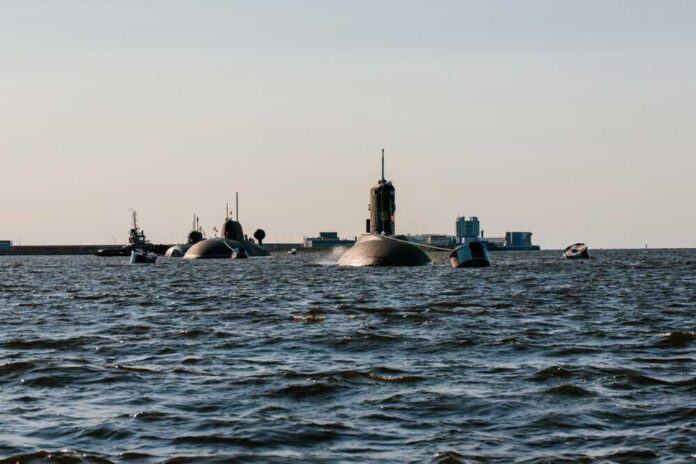
China’s nuclear submarine program is facing an embarrassing setback as satellite images show one of their newest vessels actually SANK during construction while simultaneously deploying other submarines to threaten Taiwan.
At a Glance
- Satellite imagery reveals China’s first Zhou-class nuclear submarine sank at the Shuangliu shipyard during construction, raising questions about China’s naval capabilities
- Google Maps exposed China’s “secret” submarine fleet at Qingdao base, showing six nuclear submarines including their only ballistic missile submarine
- Taiwan has launched 14-day war games simulating a Chinese invasion in 2027, deploying new weapons systems including M1A2T tanks and HIMARS
- China is building massive troop-carrying barges and its largest-ever aircraft carrier while President Xi calls Taiwan’s annexation “historical inevitability”
- The US has deployed five nuclear-powered submarines to Guam in response to China’s growing naval threat in the Western Pacific
China’s Submarine Disaster: Quality Issues Exposed
While Communist China boasts about having the world’s largest navy with over 370 ships, it turns out their quality control might be just as shoddy as everything else they manufacture. Satellite imagery has revealed an embarrassing setback for China’s naval ambitions – one of their new nuclear-powered submarines actually sank while under construction at a shipyard. You can’t make this stuff up, folks. The submarine, identified as the first of China’s new Zhou-class, was spotted docked at Shuangliu shipyard before becoming partially submerged on June 15th, according to satellite images.
“Satellite imagery appears to show China’s new nuclear-powered submarine sinking at a shipyard while under construction, a senior US defence official has said.”
A senior U.S. defense official stated the sinking was “not surprising,” which tells you everything you need to know about how our military views Chinese equipment. The incident raises serious questions about China’s training standards, equipment quality, and internal accountability. When your submarine can’t even float before leaving the shipyard, perhaps world domination should take a backseat to basic engineering. This fiasco comes as China continues making aggressive claims over the South China Sea, a vital trade route that carries trillions in global commerce annually.
Google Maps Exposes China’s “Secret” Submarine Fleet
In what must be causing absolute fits among Beijing’s military planners, China’s supposedly secret submarine fleet has been fully exposed… by Google Maps. Satellite images have revealed six nuclear submarines stationed at China’s First Submarine Base near Qingdao in the Yellow Sea. The fleet includes five conventionally armed nuclear-powered submarines (two Type 091, two Type 093A, and one unidentified) along with China’s only Type 092 nuclear-powered ballistic missile submarine. So much for operational security when your strategic assets are visible on the same platform people use to find the nearest Starbucks.
The Pentagon’s report on China’s military power acknowledges their prioritized submarine modernization: “The [People’s Liberation Army Navy] has highly prioritised modernising its submarine force but its force structure continues to grow modestly as it matures its force, integrates new technologies, and expands its shipyards.”
While Beijing works to expand its submarine capabilities, the United States isn’t sitting idle. In response to China’s naval buildup, America has deployed five nuclear-powered submarines to Guam, a critical military hub in the Western Pacific. Unlike China’s vessels, ours actually remain afloat after completion. This strategic positioning puts American naval power within striking distance of Chinese assets – sending a clear message that despite the Biden administration’s weakness on foreign policy, our military remains ready to counter Communist aggression.
Taiwan Prepares for the “Worst Case Scenario”
As China flexes its maritime muscles and Xi Jinping openly declares Taiwan’s annexation a “historical inevitability,” Taiwan isn’t taking any chances. The island democracy has launched comprehensive 14-day war games to prepare for potential conflict, simulating a full-scale Chinese assault based on a hypothetical invasion in 2027. Taiwan’s Defense Minister Wellington Koo described the exercises as preparation for the “worst case scenario” – an honest assessment rarely heard from our own administration about the Communist threat.
“In addition to the obvious questions about training standards and equipment quality, the incident raises deeper questions about the PLA’s internal accountability and oversight of China’s defence industry.”
Taiwan’s exercises include deploying new weapons systems purchased from the United States, including M1A2T tanks, HIMARS rocket systems, and anti-ship missile systems. These weapons represent the backbone of Taiwan’s defense against potential Chinese aggression. Taiwan’s strategic location in the “first island chain” makes it crucial to U.S. foreign policy in the Pacific. Should China seize control, it would dramatically enhance Communist power projection capabilities in the Western Pacific and give Beijing control over the global electronics industry – a nightmare scenario for American security and economic interests.
China’s Invasion Preparations Continue
While their submarines may occasionally sink at the dock, China’s amphibious invasion preparations continue at an alarming pace. Recent military exercises around Taiwan have included forming floating bridges with hybrid vessels – a direct preparation for amphibious landings. More concerning, China is constructing massive troop-carrying barges and its largest-ever aircraft carrier. These aren’t defensive systems; they’re offensive platforms designed specifically for projecting power beyond China’s shores and potentially invading Taiwan. The Chinese Communist Party isn’t being subtle about its intentions.
America’s constitutional commitment to Taiwan’s defense remains firm, despite the Biden administration’s confused messaging. The Communist Party’s aggressive actions in the South China Sea, their rapid naval buildup, and their increasingly bellicose rhetoric toward Taiwan demand a strong, unified American response. As we watch China’s submarine program simultaneously expand and literally sink, we must remain vigilant against the growing threat from Beijing while supporting our democratic allies in the region who stand as bulwarks against Communist expansion.

























